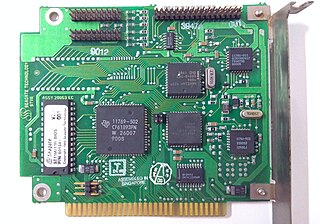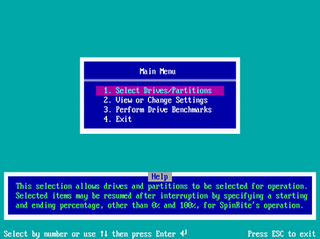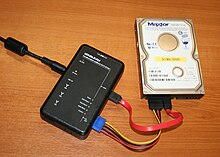
Parallel ATA (PATA), originally AT Attachment, also known as ATA or IDE is a standard interface designed for IBM PC-compatible computers. It was first developed by Western Digital and Compaq in 1986 for compatible hard drives and CD or DVD drives. The connection is used for storage devices such as hard disk drives, floppy disk drives, and optical disc drives in computers.

A hard disk drive (HDD), hard disk, hard drive, or fixed disk is an electro-mechanical data storage device that stores and retrieves digital data using magnetic storage with one or more rigid rapidly rotating platters coated with magnetic material. The platters are paired with magnetic heads, usually arranged on a moving actuator arm, which read and write data to the platter surfaces. Data is accessed in a random-access manner, meaning that individual blocks of data can be stored and retrieved in any order. HDDs are a type of non-volatile storage, retaining stored data when powered off. Modern HDDs are typically in the form of a small rectangular box.

Small Computer System Interface is a set of standards for physically connecting and transferring data between computers and peripheral devices. The SCSI standards define commands, protocols, electrical, optical and logical interfaces. The SCSI standard defines command sets for specific peripheral device types; the presence of "unknown" as one of these types means that in theory it can be used as an interface to almost any device, but the standard is highly pragmatic and addressed toward commercial requirements. The initial Parallel SCSI was most commonly used for hard disk drives and tape drives, but it can connect a wide range of other devices, including scanners and CD drives, although not all controllers can handle all devices.
RAID is a data storage virtualization technology that combines multiple physical disk drive components into one or more logical units for the purposes of data redundancy, performance improvement, or both. This is in contrast to the previous concept of highly reliable mainframe disk drives referred to as "single large expensive disk" (SLED).
A RAM drive is a block of random-access memory that a computer's software is treating as if the memory were a disk drive. It is sometimes referred to as a virtual RAM drive or software RAM drive to distinguish it from a hardware RAM drive that uses separate hardware containing RAM, which is a type of battery-backed solid-state drive.

The disk controller is the controller circuit which enables the CPU to communicate with a hard disk, floppy disk or other kind of disk drive. It also provides an interface between the disk drive and the bus connecting it to the rest of the system.

CompactFlash (CF) is a flash memory mass storage device used mainly in portable electronic devices. The format was specified and the devices were first manufactured by SanDisk in 1994.
Disk formatting is the process of preparing a data storage device such as a hard disk drive, solid-state drive, floppy disk, memory card or USB flash drive for initial use. In some cases, the formatting operation may also create one or more new file systems. The first part of the formatting process that performs basic medium preparation is often referred to as "low-level formatting". Partitioning is the common term for the second part of the process, dividing the device into several sub-devices and, in some cases, writing information to the device allowing an operating system to be booted from it. The third part of the process, usually termed "high-level formatting" most often refers to the process of generating a new file system. In some operating systems all or parts of these three processes can be combined or repeated at different levels and the term "format" is understood to mean an operation in which a new disk medium is fully prepared to store files. Some formatting utilities allow distinguishing between a quick format, which does not erase all existing data and a long option that does erase all existing data.

A USB flash drive is a data storage device that includes flash memory with an integrated USB interface. It is typically removable, rewritable and much smaller than an optical disc. Most weigh less than 30 g (1 oz). Since first appearing on the market in late 2000, as with virtually all other computer memory devices, storage capacities have risen while prices have dropped. As of March 2016, flash drives with anywhere from 8 to 256 gigabytes (GB) were frequently sold, while 512 GB and 1 terabyte (TB) units were less frequent. As of 2018, 2 TB flash drives were the largest available in terms of storage capacity. Some allow up to 100,000 write/erase cycles, depending on the exact type of memory chip used, and are thought to physically last between 10 and 100 years under normal circumstances.

SpinRite is a computer program for scanning magnetic data storage devices such as hard disks, recovering data from them and refreshing their surfaces. The first version was released in 1987 by Steve Gibson. The current version, 6.0, was released in 2004.
Data remanence is the residual representation of digital data that remains even after attempts have been made to remove or erase the data. This residue may result from data being left intact by a nominal file deletion operation, by reformatting of storage media that does not remove data previously written to the media, or through physical properties of the storage media that allow previously written data to be recovered. Data remanence may make inadvertent disclosure of sensitive information possible should the storage media be released into an uncontrolled environment.
The Gutmann method is an algorithm for securely erasing the contents of computer hard disk drives, such as files. Devised by Peter Gutmann and Colin Plumb and presented in the paper Secure Deletion of Data from Magnetic and Solid-State Memory in July 1996, it involved writing a series of 35 patterns over the region to be erased.
In computing, data recovery is a process of salvaging deleted, inaccessible, lost, corrupted, damaged, or formatted data from secondary storage, removable media or files, when the data stored in them cannot be accessed in a usual way. The data is most often salvaged from storage media such as internal or external hard disk drives (HDDs), solid-state drives (SSDs), USB flash drives, magnetic tapes, CDs, DVDs, RAID subsystems, and other electronic devices. Recovery may be required due to physical damage to the storage devices or logical damage to the file system that prevents it from being mounted by the host operating system (OS).

A solid-state drive (SSD) is a solid-state storage device that uses integrated circuit assemblies to store data persistently, typically using flash memory, and functioning as secondary storage in the hierarchy of computer storage. It is also sometimes called a semiconductor storage device, a solid-state device or a solid-state disk, even though SSDs lack the physical spinning disks and movable read–write heads used in hard disk drives (HDDs) and floppy disks. SSD also has rich internal parallelism for data processing.

In computer storage, disk buffer is the embedded memory in a hard disk drive (HDD) or solid state drive (SSD) acting as a buffer between the rest of the computer and the physical hard disk platter or flash memory that is used for storage. Modern hard disk drives come with 8 to 256 MiB of such memory, and solid-state drives come with up to 4 GB of cache memory.
Hardware-based full disk encryption (FDE) is available from many hard disk drive (HDD/SSD) vendors, including: ClevX, Hitachi, Integral Memory, iStorage Limited, Micron, Seagate Technology, Samsung, Toshiba, Viasat UK, Western Digital. The symmetric encryption key is maintained independently from the computer's CPU, thus allowing the complete data store to be encrypted and removing computer memory as a potential attack vector.
Data erasure is a software-based method of overwriting the data that aims to completely destroy all electronic data residing on a hard disk drive or other digital media by using zeros and ones to overwrite data onto all sectors of the device in an irreversible process. By overwriting the data on the storage device, the data is rendered irrecoverable and achieves data sanitization.
shred is a command on Unix-like operating systems that can be used to securely delete files and devices so that it is extremely difficult to recover them, even with specialized hardware and technology; assuming it's even possible to recover the file at all. It is a part of GNU Core Utilities.
A trim command allows an operating system to inform a solid-state drive (SSD) which blocks of data are no longer considered to be 'in use' and therefore can be erased internally.

Mobile device forensics is a branch of digital forensics relating to recovery of digital evidence or data from a mobile device under forensically sound conditions. The phrase mobile device usually refers to mobile phones; however, it can also relate to any digital device that has both internal memory and communication ability, including PDA devices, GPS devices and tablet computers.













